What's inside
What's inside
 Key Ingredients
Key Ingredients

 Benefits
Benefits

 Concerns
Concerns

No concerns
 Ingredients Side-by-side
Ingredients Side-by-side

Water
Skin ConditioningGlycerin
HumectantIsononyl Isononanoate
EmollientPEG-20 Methyl Glucose Sesquistearate
EmulsifyingPhenoxyethanol
PreservativeBakuchiol
AntimicrobialAcrylates/C10-30 Alkyl Acrylate Crosspolymer
Emulsion StabilisingChlorphenesin
AntimicrobialBisabolol
MaskingXanthan Gum
EmulsifyingPotassium Hydroxide
BufferingDisodium EDTA
Aloe Barbadensis Leaf Juice
Skin ConditioningMaltodextrin
AbsorbentPotassium Sorbate
PreservativeSodium Benzoate
MaskingWater, Glycerin, Isononyl Isononanoate, PEG-20 Methyl Glucose Sesquistearate, Phenoxyethanol, Bakuchiol, Acrylates/C10-30 Alkyl Acrylate Crosspolymer, Chlorphenesin, Bisabolol, Xanthan Gum, Potassium Hydroxide, Disodium EDTA, Aloe Barbadensis Leaf Juice, Maltodextrin, Potassium Sorbate, Sodium Benzoate
Water
Skin ConditioningGlycerin
HumectantSqualane
EmollientBakuchiol
AntimicrobialTranexamic Acid
AstringentCaprylic/Capric Triglyceride
MaskingBisabolol
MaskingGlutathione
Chondrus Crispus Extract
Skin ConditioningTetrahexyldecyl Ascorbate
AntioxidantTocopherol
AntioxidantUbiquinone
AntioxidantAllantoin
Skin ConditioningLaminaria Ochroleuca Extract
Skin ConditioningAscophyllum Nodosum Extract
Skin ConditioningFucus Vesiculosus Extract
EmollientCamellia Oleifera Leaf Extract
AstringentPalmitoyl Tetrapeptide-7
Skin ConditioningPalmitoyl Hexapeptide-12
Skin ConditioningSodium Hyaluronate
HumectantDipotassium Glycyrrhizate
HumectantGlycyrrhiza Glabra Root Extract
BleachingPalmitoyl Tripeptide-1
Skin ConditioningPhenoxyethanol
PreservativeXanthan Gum
EmulsifyingBenzyl Alcohol
PerfumingPhospholipids
Skin ConditioningRetinal
Skin ConditioningSodium Gluconate
Skin ConditioningSodium Citrate
BufferingCitric Acid
BufferingEthylhexylglycerin
Skin ConditioningWater, Glycerin, Squalane, Bakuchiol, Tranexamic Acid, Caprylic/Capric Triglyceride, Bisabolol, Glutathione, Chondrus Crispus Extract, Tetrahexyldecyl Ascorbate, Tocopherol, Ubiquinone, Allantoin, Laminaria Ochroleuca Extract, Ascophyllum Nodosum Extract, Fucus Vesiculosus Extract, Camellia Oleifera Leaf Extract, Palmitoyl Tetrapeptide-7, Palmitoyl Hexapeptide-12, Sodium Hyaluronate, Dipotassium Glycyrrhizate, Glycyrrhiza Glabra Root Extract, Palmitoyl Tripeptide-1, Phenoxyethanol, Xanthan Gum, Benzyl Alcohol, Phospholipids, Retinal, Sodium Gluconate, Sodium Citrate, Citric Acid, Ethylhexylglycerin
 Reviews
Reviews

Ingredients Explained
These ingredients are found in both products.
Ingredients higher up in an ingredient list are typically present in a larger amount.
Bakuchiol is a plant-derived antioxidant (it's vegan!). It is often called the replacement for retinol although it is not part of the same family.
It has similar effects as retinol: skin smoothing, reducing discoloration, and preventing wrinkles. It does not cause as much irritation as traditional retinoids.
Bakuchiol works by breaking down free radicals and stimulating collagen production in skin.
Combining bakuchiol with retinol will not have adverse side effects. Studies show using them will just boost the benefits. Bakuchiol is also found to help stabilize retinol.
While bakuchiol does not make the skin more sun sensitive, we recommend wearing SPF on a daily basis.
Read more about traditional retinol
Learn more about BakuchiolBisabolol is famous for its skin soothing properties. It does this by blocking inflammatory signals, helping to reduce your body's reaction to irritation.
This ingredient also interferes with the process of hyperpigmentation. This can help with reducing dark spots and uneven tone.
Bisabolol is an antioxidant. Antioxidants help fight free-radicals. Free-radicals are molecules that may damage your skin cells. By fighting these free-radicals, Bisabolol may slow down signs of aging.
Studies have shown Bisabolol to have antimicrobial properties and may be a fungicide. These properties help preserve a product's shelf life.
All these properties makes bisabolol a great skin barrier helper ingredient.
Bisabolol also helps the absorption of other ingredients.
Note: Synthetic Bisabolol has been shown to be less effective.
Learn more about BisabololGlycerin is already naturally found in your skin. It helps moisturize and protect your skin.
A study from 2016 found glycerin to be more effective as a humectant than AHAs and hyaluronic acid.
As a humectant, it helps the skin stay hydrated by pulling moisture to your skin. The low molecular weight of glycerin allows it to pull moisture into the deeper layers of your skin.
Hydrated skin improves your skin barrier; Your skin barrier helps protect against irritants and bacteria.
Glycerin has also been found to have antimicrobial and antiviral properties. Due to these properties, glycerin is often used in wound and burn treatments.
In cosmetics, glycerin is usually derived from plants such as soybean or palm. However, it can also be sourced from animals, such as tallow or animal fat.
This ingredient is organic, colorless, odorless, and non-toxic.
Glycerin is the name for this ingredient in American English. British English uses Glycerol/Glycerine.
Learn more about GlycerinPhenoxyethanol is a preservative that has germicide, antimicrobial, and aromatic properties. Studies show that phenoxyethanol can prevent microbial growth. By itself, it has a scent that is similar to that of a rose.
It's often used in formulations along with Caprylyl Glycol to preserve the shelf life of products.
Water. It's the most common cosmetic ingredient of all. You'll usually see it at the top of ingredient lists, meaning that it makes up the largest part of the product.
So why is it so popular? Water most often acts as a solvent - this means that it helps dissolve other ingredients into the formulation.
You'll also recognize water as that liquid we all need to stay alive. If you see this, drink a glass of water. Stay hydrated!
Learn more about WaterXanthan gum is used as a stabilizer and thickener within cosmetic products. It helps give products a sticky, thick feeling - preventing them from being too runny.
On the technical side of things, xanthan gum is a polysaccharide - a combination consisting of multiple sugar molecules bonded together.
Xanthan gum is a pretty common and great ingredient. It is a natural, non-toxic, non-irritating ingredient that is also commonly used in food products.
Learn more about Xanthan Gum